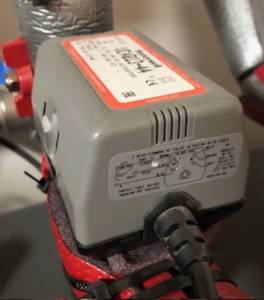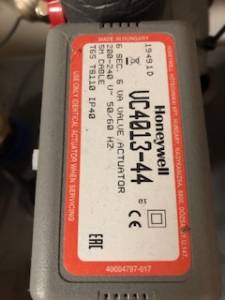Heat pump delta T too low - 2c
Sorry, attempted to correct by editing but failed; the Daikin system is an EDL08 8kW monobloc unit; I have left the ‘installer’ settings as is but assume that the PWM pump is set to a Delto T of 5. My setting of the lockshield valves on the emitters gives me an internal circuit Delto T of some 3.5 - 4 and my installer told me that this is not so critical as the ASHP pump for the LLH provides that little bit of flexibility. Regards, Toodles.
Toodles, heats his home with cold draughts and cooks food with magnets.
Posted by: @toodlesThere is a secondary pump to control flow to the 9 emitters plus dual fuel towel rail, the pump is a Wilo variable speed jobbie (set fairly low as this not only gives a good Delta T for the emitters but runs very quietly too). My installer told me the Daikin monobloc pump is good at self regulation and with the LLH, the Delta T for the emitters is less critical this way.
Interesting.... we also have a Secondary pump. However both pumps are external and adjusted manually to reach the desired deltaT however this can vary between dt5 and dt8.
I believe there’s is a Mitsubishi pump which is controlled via the main controller but we weren’t offered it nor were we aware of the option prior to installation.
@toodles You have 3 settings on the PWM settings in the MMI controller.
You can set it to:
UFH which is slow response, adjustable DT
Fan convector which is fast response, adjustable DT
Radiators which is fast response but fixed DT of 8, I think this was something to do with lockshield valves making a lot of noise at DT5. You can set radiators as "fan coils" on the MMI which will give you adjustability of the DT however with having a secondary pump you may have already set it too its most efficient.
@SUNandAIR you are likely better having a fixed DT on your primary so both sides of the system attempt to be in balance. More often than not its whenever pre-plumbed cylinders are used.
Cheers
Ant
@sunandair I was not as aware of the virtues of the LLH design as I might have been but trusted my installers to specify the best configuration; apart from the current inability to use a Homely system due to the two-pump control requirement, I am very satisfied with the overall system. I did have a gripe about the controls when installed as the secondary pump was controlled by the Heatmiser RF switch via a contactor and on the rare occasions it switched off (I had the ‘cruise control’ otherwise known as setting up the lwt with weather compensation so that the system is well balanced to modulate within the energy requirement day to day) there was a rather loud ‘clack’ from the contactor box. This has been changed for a relay which is noticeably quieter and less likey to disturb us at night as the aiing cupboard is in our bedroom. As mentioned, the ASHP settings regulate the temperature very evenly so the Heatmiser is really only there to set a maximum temperature or enable us to take manual control if wished though this has not been necessary as yet. I might add that I added the ‘Homely’ requirement to the set up post installation as the unit was not available for any Daikin models at that time, so not the installer’s fault t all. Regards, Toodles.
Toodles, heats his home with cold draughts and cooks food with magnets.
Posted by: @ant87
@SUNandAIR you are likely better having a fixed DT on your primary so both sides of the system attempt to be in balance. More often than not its whenever pre-plumbed cylinders are used.
Thanks For your help...
There are a few characteristics which appear to differ from one HP make to another HP make. In this case the relevant characteristic of the Mitsubishi Ecodan is that you cannot set a fixed DT in any of the settings menus. Whereas in their system you can set a Primary Flow rate then the programme attempts to maintain an optimum DT of close to 5DT. The trick is to correctly set up the external circulating pump speed to achieve the optimum flow rate so it doesn’t drift lower than 5 or higher than 8. This has the advantage of providing an efficient DT while driving the circulating fluid at a constant flow rate as it passes through the low loss header and returns to the heat pump.
This also means the flow rate through the secondary circuit can be adjusted to match the Primary Flow because it is a constant flow rate. That’s the theory but in tests we have still had a 1 to 1.5c loss of temperature across Primary Flow and Secondary Flow (at40c) so there’s are still some losses through the LLH.
Im sure there are many reasons for correctly specifying a LLH but I think they have also been over specified for retrofits in the recent past as a reassurance against unknown pipework and undersized emitters.
At the end of the day our objective is to decarbonise and make our systems as efficient as possible. Or at least, that’s what I paid a lot of money for and I’m trying to do. 🥺😜
@ant87 Thank you Ant87, when I checked after installation and commissioning, the system was set in the MMI for radiators, but I'll bear that in mind should further tweaking be needed, Regards, Toodles.
Toodles, heats his home with cold draughts and cooks food with magnets.
@heacol and @iancalderbank reading this thread and given the general dislike of the Honeywell actuator/ valves...I have a 16kw Daikin Altherma HT which has a Honeywell VC4013-44 valve (pics attached) - is this a type of actuator/ valve combo that would do well to be replaced with one of the Belimo actuator/ valves? Is that just a straight swap for someone reasonably competent (probably not me!)?
@marzipan71 You may befit from replacing the valve, it will depend on the current flow rate and system design. If you have a buffer tank, it will probably make little difference.
Thanks @heacol that makes sense - we have a LLH so I assume that counts as a buffer tank for the purposes of deciding if this is worthwhile (i.e., probably not). Thanks again.
- 26 Forums
- 2,381 Topics
- 54 K Posts
- 159 Online
- 6,065 Members
Join Us!
Worth Watching
Latest Posts
-
RE: Recommended home battery inverters + regulatory matters - help requested
I believe you will need a separate earth if considering...
By Old_Scientist , 2 hours ago
-
RE: New Fogstar 15.5kWh upright solution
@batpred It's a shame you haven't bought any of thes...
By Bash , 4 hours ago
-
RE: Solar Power Output – Let’s Compare Generation Figures
@transparent 1P only. Wish I was on 3P, we have a lo...
By Papahuhu , 5 hours ago
-
RE: Octopus Cosy Heat Pump Owners & Discussion Thread
@jamespa There is no reason the Cosy couldn't auto-bala...
By swwils , 5 hours ago
-
RE: Connecting Growatt SPH5000 over wired ethernet rather than wireless
Well well well.. turns out my WiFi dongle is actually t...
By z8lccda , 6 hours ago
-
RE: Solis S6-EH1P8K-L-PLUS – Why I Chose It and What I’ve Learned So Far
I am now considering adding a second battery to my setu...
By Batpred , 8 hours ago
-

@abam48 Did you go for this option and does it work wel...
By dgclimatecontrol , 10 hours ago
-
RE: Weather compensation- why you should use it
Okay thanks both. Yes the house is very nic...
By jamesh , 11 hours ago
-
RE: Cascade 2x Grant Areona 10kw ASHP - Ongoing setup issues
Well this morning the master bedroom & ensuite were...
By adam , 12 hours ago
-
Happy New Year to all fellow tinkerers. I've been doin...
By Sheriff Fatman , 12 hours ago
-
RE: Gen 6 Samsung ASHP losing 20C of DHW in 60 min directly after generation
@andbeck Couple of questions and a thought: I can...
By JamesPa , 13 hours ago
-

RE: Setback savings - fact or fiction?
That is correct, the setback period was Feb to Apr 2025...
By cathodeRay , 15 hours ago
-
RE: Havenwise App Help & Forum Support – Get the Most from Your Heat Pump
Fair enough. The reason for asking was that Henri's po...
By Sheriff Fatman , 15 hours ago
-
RE: Eve Thermo Gen 5 Smart TRV
Interesting. Are they getting bunged up do you think, ...
By JamesPa , 15 hours ago
-

Thanks for your comments @old_scientist. It sounds like...
By SUNandAIR , 15 hours ago
-
RE: Radiator sizing sanity check
@jamespa Thanks for the help. Yes, I’m going to push fo...
By Papahuhu , 16 hours ago
-
RE: Help needed with Grant Aerona 3 issues
@fleurcules thats great news. My advice is to make sur...
By JamesPa , 17 hours ago
-
RE: Optimum new build house design for Heat Pump
The spacing needs to be designed though a software or b...
By ASHP-BOBBA , 17 hours ago
-

@jamespa I share your cynicism. I do suspect there’s a...
By Mars , 1 day ago
-

RE: Global Energy Systems Thurso ASHP
Great point Benson. In winter, on mild days, our 18kW w...
By Mars , 1 day ago







